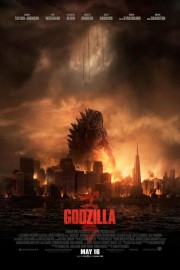Godzilla (’14)
I wonder how many people going to see Gareth Edwards’s “Godzilla” have ever watched the 1954 original. I’m not talking about the “Americanized” version, with Raymond Burr inserted into the action, but the original, Japanese epic. If you haven’t, I suggest doing so, preferably on the Criterion Collection edition that has both versions on it. It’s quite a spectacle, and a deeply haunting film that illuminates the choices made by Edwards and screenwriters in their film.
I reviewed the original film last year, so you can read my thoughts on that one another time. About Edwards’s film, the first thing that needs to be said is that it forever removes the lingering bad taste of Roland Emmerich’s 1998 film, and shows just how far the “Independence Day” director missed the mark with that film (of course, watching the original film did that for me). It gets back to the primal terror nuclear catastrophe can cause, which was the central metaphor of the original (made less than a decade after Hiroshima and Nagasaki), but does so in an awe-inspiring manner that focuses less on the spectacle of destruction (though there’s plenty of that, to be sure), and more on the emotional impact on the characters. Remember folks: in the end, it all comes down to story, regardless of how much money is thrown at a movie.
The film begins with opening credits that look like something out of “JFK,” with flashes of nuclear testing and redacted government files as Alexandre Desplat’s score (far removed from the elegance of “Philomena” and the quirkiness of “Moonrise Kingdom”) gets in the mood for the monster mashing to come. Then the film starts proper in 1999 Japan, where Joe (Bryan Cranston) is working at a nuclear power plant with his wife (Juliette Binoche), while their son, Ford, goes to grade school nearby. Joe begins seeing patterns in seismic activity, but it’s hardly an earthquake, and we get hints of what it might be when two scientists (Ken Watanabe and Sally Hawkins) explore the site of a construction accident. However, whatever it is causes a meltdown at the power plant, resulting in Joe’s wife’s death, and the evacuation of the city. Fifteen years later, Ford (played by Aaron Taylor-Johnson, from the “Kick-Ass” films) is married to a nurse (Elizabeth Olsen) with a son of his own, and is in the Navy as an explosives expert, and he has to return to Japan to bail out his father, who is obsessed with the truth about what happened that day. Needless to say, what he finds is bigger than he ever expected.
If you saw Edwards’s low-budget first feature film, “Monsters,” you already know what a huge fan of Godzilla, both the monster and the films, the director is, and he pours all of that passion into the way he brings Max Borenstein’s screenplay, with a story by Dave Callaham, to life. Yes, the film is part of the recent trend towards “dark blockbusters,” something Warner Bros. seems to be at the forefront with after Chris Nolan’s “Dark Knight” trilogy and the later “Harry Potter” films, and it’s a little too serious for it’s own good at times, but given how far to the opposite direction Emmerich pulled Godzilla with his campy version, it was necessary, I think, to remind people of the big guy’s cinematic roots. In his debut film by Ishiro Honda, Godzilla was a representation of the fear the Japanese people had for apocalyptic destruction after the bombing of Hiroshima and Nagasaki, and the aftermath of WWII. Edwards and his writers don’t have that perspective themselves, but in the post-9/11 United States, and in a time when global warming poses a real threat to our survival, that anxiety is easily understood, as well as a distrust in our government that Cranston’s character vocalizes when he realizes that he hasn’t been told the entire story. Anyone simply expecting “disaster porn,” as these type of movies can be referred to, is in for a rude awakening, but also a pleasant surprise if you stick with the film.
“Monsters” was an impressive display of visual effects wizardry given it’s budgetary limitations, so it shouldn’t be shocking that when given considerably greater resources for “Godzilla,” he delivers the goods big time. This should be considered one of the early front-runners for Best Visual Effects and the two sound categories considering the remarkable sights and sounds on display. No, they didn’t go with a guy in a rubber suit, but they didn’t completely abandon the way that Godzilla moved, either. (The same goes with the other monsters in this film. No Mothra or Rodan yet, but I wouldn’t be surprised if they show up in a sequel or two.) Yes, Godzilla looks like he’s put on some weight, as some people in Japan have complained, but he’s just as powerful in a fight as ever– in other words, I’m guessing it’s all muscle, folks. The use of the classic Godzilla roar, though, puts Edwards’s interpretation of the “king of the monsters” on the shortlist of one of the greatest “Godzilla” movies ever made. I guess he’s off to a galaxy far, far away for his next film with the first “Star Wars” “spin-off” film, but hopefully we’ll get his next adventure with Japan’s most iconic movie creature soon after.










